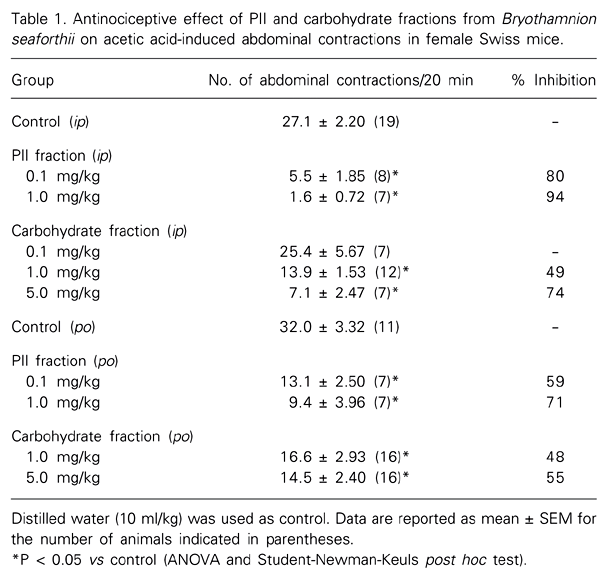Bryothamnion seaforthii, a red alga common to the Northeastern coast of Brazil, was used to prepare the protein fraction F0/60 by ammonium sulfate precipitation. The chromatography of F0/60 on DEAE-Sephadel column resulted in two lectin fractions, PI and PII, which have antinociceptive properties in rodents. We determined the antinociceptive activity of the PII fraction and of a carbohydrate-containing fraction (CF) in mice. The CF was prepared from the dried algae, after digestion with 100 mM sodium acetate, pH 6.0, containing 5 mM cysteine, EDTA and 0.4% papain, at 60ºC. A 10% cetylpyridinium chloride was added to the filtrate, and the precipitate was dissolved with 2 M NaCl:ethanol (100:15, v/v) followed by the carbohydrate precipitation with ethanol. The final precipitate, in acetone, was dried at 25ºC. The PII fraction markedly inhibited acetic acid-induced abdominal writhing after ip administration (control: 27.1 ± 2.20; PII 0.1 mg/kg: 5.5 ± 1.85; 1 mg/kg: 1.6 ± 0.72 writhes/20 min) and after oral administration (control: 32.0 ± 3.32; PII 0.1 mg/kg: 13.1 ± 2.50; 1 mg/kg: 9.4 ± 3.96 writhes/20 min). PII was also effective against both phases of pain induced by 1% formalin (control, ip: 48.2 ± 2.40 and 27.7 ± 2.56 s; PII: 1 mg/kg, ip: 34.3 ± 5.13 and 5.6 ± 2.14 s; control, po: 44.5 ± 3.52 and 25.6 ± 2.39 s; PII 5 mg/kg, po: 26.5 ± 4.67 and 15.3 ± 3.54 s for the 1st and 2nd phases, respectively) and in the hot-plate test. The CF (ip) also displayed significant antinociceptive properties in all tests but at higher doses (1 and 5 mg/kg, ip and po). Thus, CF at the dose of 5 mg/kg significantly inhibited writhes (ip: 7.1 ± 2.47 and po: 14.5 ± 2.40 writhes/20 min) as well as the 1st (po: 19.6 ± 1.74 s) and 2nd (po: 7.1 ± 2.24 s) phases of the formalin test compared to controls ip and po. The antinociceptive effects of both the PII and CF in the formalin and hot-plate tests were prevented at least partially by pretreatment with the opioid receptor antagonist naloxone (2 mg/kg, sc). Moreover, both fractions retained antinociceptive activity in the acetic acid-induced writhing test following heating, a procedure which abolished the hemagglutinating activity of the fraction, presumably due to lectins also present. Finally, both fractions also prolonged the barbiturate-induced sleeping time. These results indicate that carbohydrate molecules present in the PII (26.8% carbohydrate) and CF (21% of the alga dried weight) obtained from B. seaforthii display pronounced antinociceptive activity which is resistant to heat denaturation and is mediated by an opioid mechanism, as indicated by naloxone inhibition.
Algae; Antinociceptive activity; Carbohydrate; Bryothamnion seaforthii





